Global Burden of Disease 2023
Findings from the GBD 2023 Study
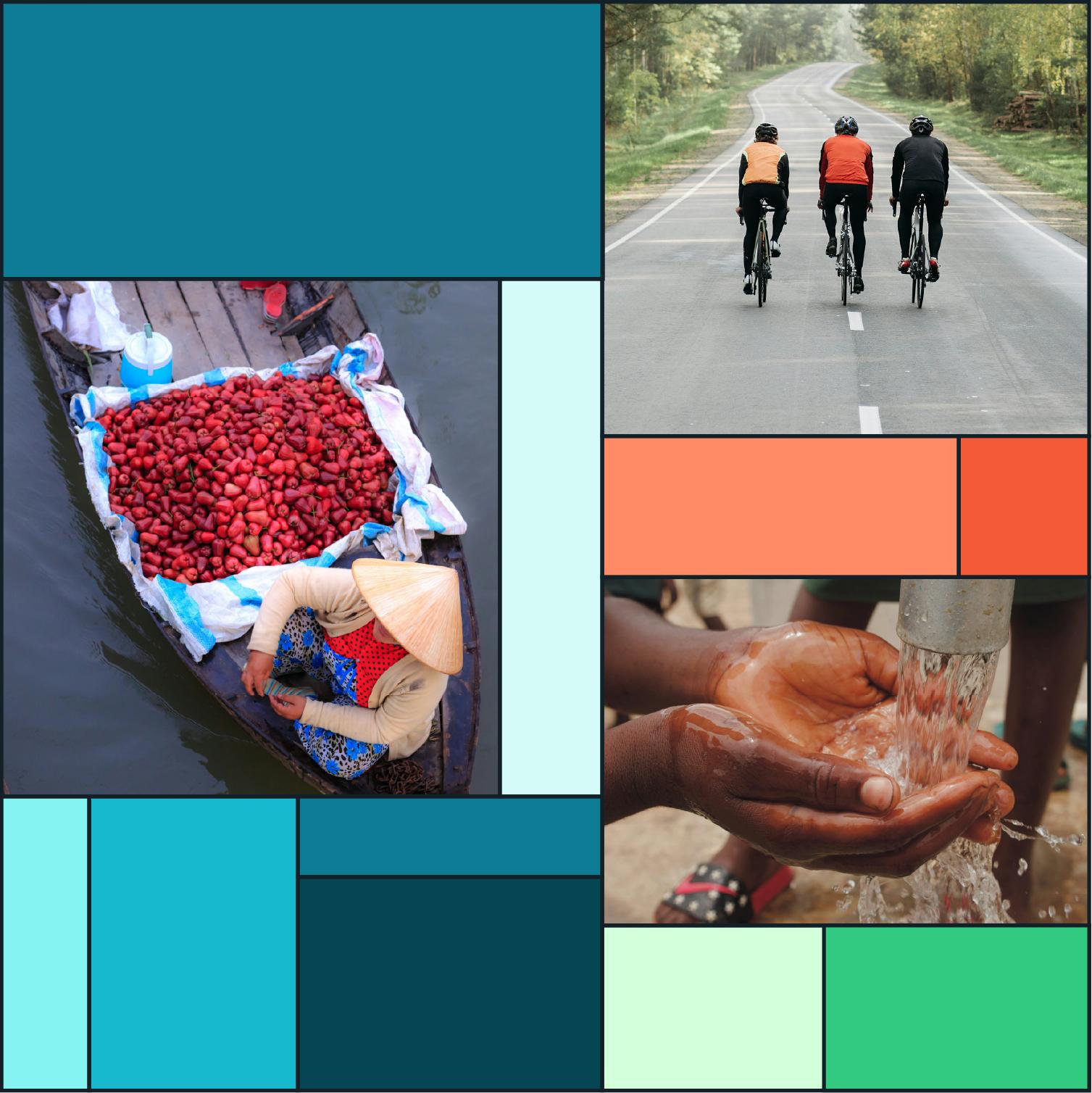


Findings from the GBD 2023 Study
INSTITUTE FOR HEALTH METRICS AND EVALUATION
UNIVERSITY OF WASHINGTON
This booklet was prepared by the Institute for Health Metrics and Evaluation (IHME) through core funding from the Gates Foundation. The views expressed are those of the authors. The contents of this publication may be reproduced and redistributed in whole or in part, provided the intended use is for noncommercial purposes, the contents are not altered, and full acknowledgment is given to IHME.
This work is licensed under the Creative Commons Attribution-NonCommercial-NoDerivs 4.0 Unported License. To view a copy of this license, please visit https://creativecommons.org/licenses/by-nc-nd/4.0/ For any usage that falls outside of these license restrictions, please contact IHME Global Engagement at engage@healthdata.org
Citation: Institute for Health Metrics and Evaluation (IHME). Global Burden of Disease 2023: Findings from the GBD 2023 Study. Seattle, WA: IHME, 2025.
Institute for Health Metrics and Evaluation 3980 15th Ave NE Seattle WA 98195
USA
www.healthdata.org
© 2025 Institute for Health Metrics and Evaluation
To request copies of this report, please contact IHME:
Telephone: +1-206-897-2800
Fax: +1-206-897-2899
Email: engage@healthdata.org
Introduction
Glossary of terms
8 Global health rebounds post-COVID-19, but people still die prematurely in many regions
10 Amid COVID-19 recovery, some regions see rising mortality
12 World made rapid progress fighting infectious diseases, but diabetes, mental disorders, and obesity/overweight are mounting challenges
15 GBD 2023 study resources
the latest global burden of diseases, injuries, and risk factors study (gbd) – an update through the year 2023 – provides a comprehensive picture of the world’s health following the COVID-19 pandemic. Life expectancy has returned to prepandemic levels in most countries. Also, communities have made stunning progress in combatting communicable diseases and saving newborns’ lives through collective action. However, despite these improvements, newborn disorders, lower respiratory infections, and diarrheal diseases still appear among the top 10 causes of health loss worldwide. The fight against these diseases is far from over, and cuts to development assistance for health imperil countries’ success in these areas.
Non-communicable diseases are a growing challenge, particularly in low-resource settings. For example, when it comes to cardiovascular diseases, people die, on average, 30 years earlier in some countries compared to others, revealing inequalities in resources and interventions. Targeting risk factors – including high blood pressure, air pollution, smoking, high blood sugar, and obesity/overweight (high body mass index) – is essential for preventing early death and poor health from non-communicable diseases.
When it comes to risk factors, GBD researchers found that addressing the 88 tracked in this research could eliminate up to half of the healthy years lost each year globally. Encouragingly, the research suggests that health loss from eight of the top 10 risk factors declined between 2010 and 2023. At the same time, health loss from two leading risk factors – high blood sugar and high body mass index – increased during this period.
How will people fare as they face these different diseases, injuries, and risk factors that the GBD research highlights, and how will their leaders respond? Even amid the extreme loss of life during the COVID-19 pandemic, the health trends of the past three decades demonstrate that the global community can work together to confront major threats. Despite setbacks, people living longer lives in better health is still within reach.
Disability-adjusted life years (DALYs)
Life expectancy
Risk factors
Socio-demographic Index (SDI)
Super-regions
Years lived with disability (YLDs)
Years of life lost (YLLs)
Years of healthy life lost to premature death and disability. DALYs are the sum of years of life lost (YLLs) and years lived with disability (YLDs).
Number of years a person is expected to live based on their present age. For GBD, the life expectancy for an age group (e.g., 50- to 54-year-olds), is determined from the first year in the age range.
Potentially modifiable causes of disease and injury.
A summary measure that identifies where countries or other geographic areas sit on the spectrum of development. Expressed on a scale of 0 to 1, SDI is a composite average of the rankings of the incomes per capita, average educational attainment, and fertility rates of all areas in the GBD study.
Seven world regions whose constituent countries are grouped on the basis of cause of death patterns:
• Central Europe, Eastern Europe, and Central Asia
• High-income
• Latin America and the Caribbean
• North Africa and the Middle East
• South Asia
• Southeast Asia, East Asia, and Oceania
• Sub-Saharan Africa
Years of life lived with any short-term or long-term health loss.
Years of life lost due to premature mortality.
After killing 18 million people, COVID-19 dropped from the leading cause of death worldwide in 2021 to the 20th-leading cause in 2023.
Age-adjusted mortality from non-communicable diseases – especially cardiovascular diseases and cancers – is highest in low Socio-demographic Index regions,1 especially in parts of sub-Saharan Africa.2
Many countries – particularly those with the fewest resources – need better access to prevention and treatment for non-communicable diseases.
Incorporated 55,761 data sources.
Researchers developed novel metrics, including the probability of dying before age 70 and the mean age at death from nearly 300 different causes.
Most comprehensive analysis of the world’s health following COVID-19.
1The Socio-demographic Index is a combined metric that incorporates income, education, and fertility
2Measured in age-standardized deaths per 100,000 people
COVID-19 killed 18 million people from 2019 to 2023 but was no longer a major cause of death in 2023.
Leading causes of death worldwide in 2021 compared to 2023 (age-adjusted)3
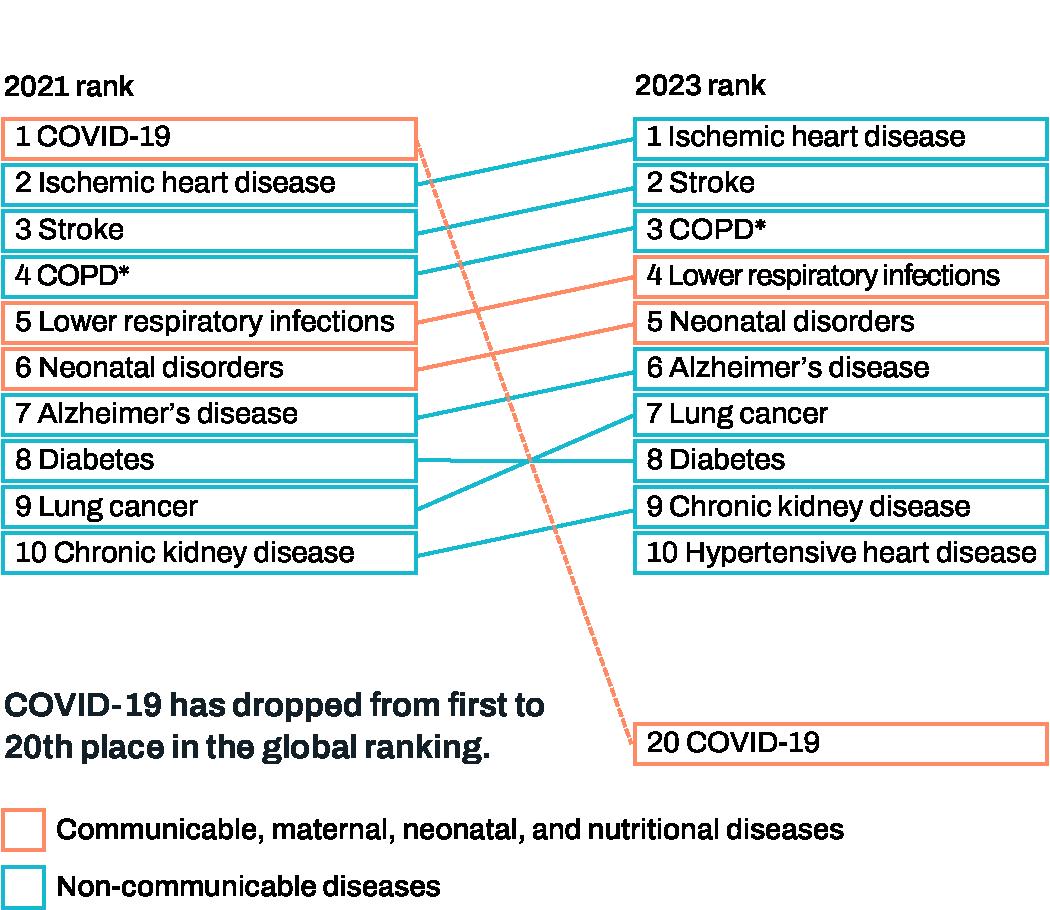
3Age-standardized deaths per 100,000 people, all sexes
*Chronic obstructive pulmonary disease
Diabetes, drug use disorders, violence, and heat waves pose some of the fastest-rising threats to human health.
Percentage annual increase in deaths due to select causes from 2013 to 2023

While mortality from non-communicable diseases is dropping steadily in areas with higher Socio-demographic Index (SDI) levels, it remains stubbornly high in low SDI countries.
Mortality from non-communicable diseases by Socio-demographic Index level (age-adjusted), 1990–20234
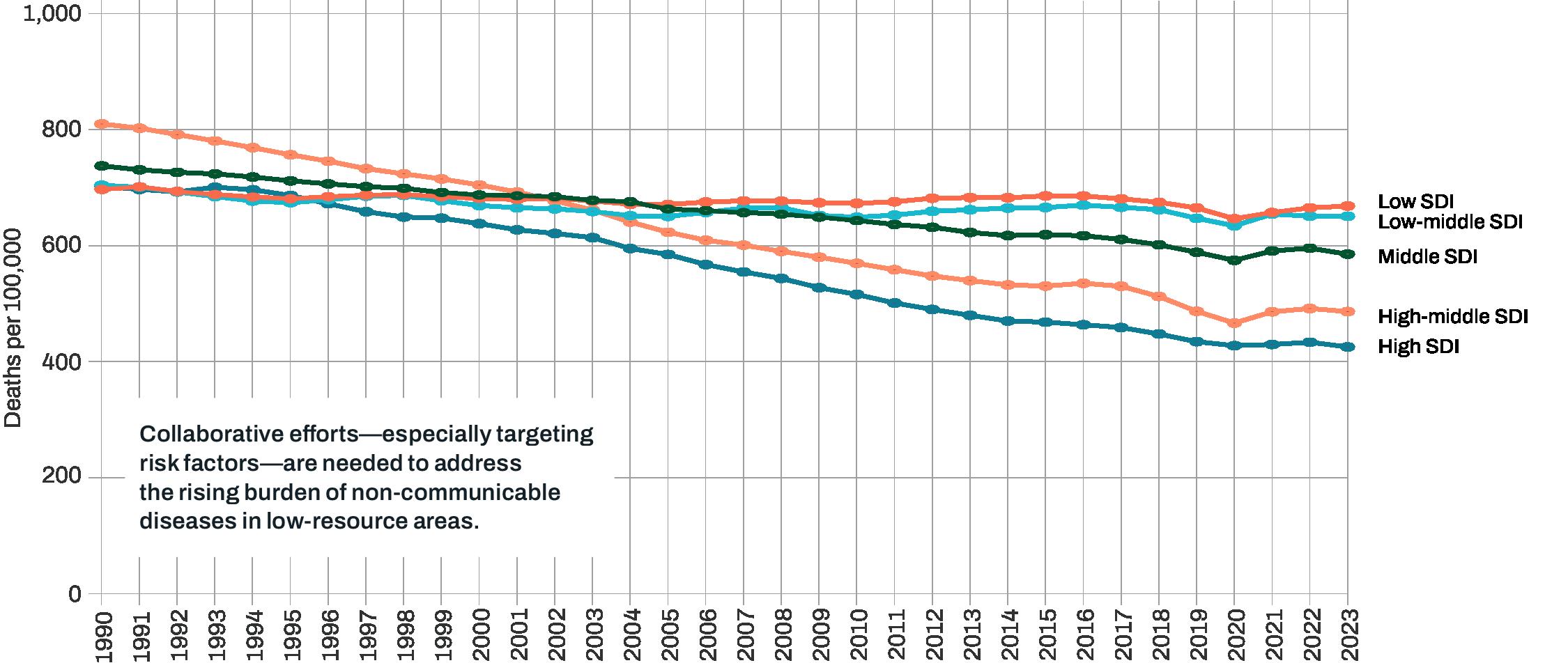
4Age-standardized deaths per 100,000, all sexes
Stronger prevention, diagnosis, and treatment are needed to reduce early death from cardiovascular diseases and other non-communicable diseases, where the average age of death varies widely across countries.
Mean age of death from cardiovascular diseases, 2023

Life expectancy and mortality have largely returned to pre-COVID-19 levels.
Mortality among children, adolescents, and young adults has declined in most regions except Eastern Europe and high-income North America.
New data and methods uncovered higher mortality among women in sub-Saharan Africa than previously reported.
New and improved methods, leading to more accurate estimates than ever before.
Utilizes over 24,000 data sources, including vital records, censuses, and surveys.
Analytical improvements reveal novel insights into mortality rates in sub-Saharan African countries.
Life expectancy has returned to pre-pandemic levels in two-thirds of countries and territories.
Life expectancy among GBD super-regions, 2013–20231
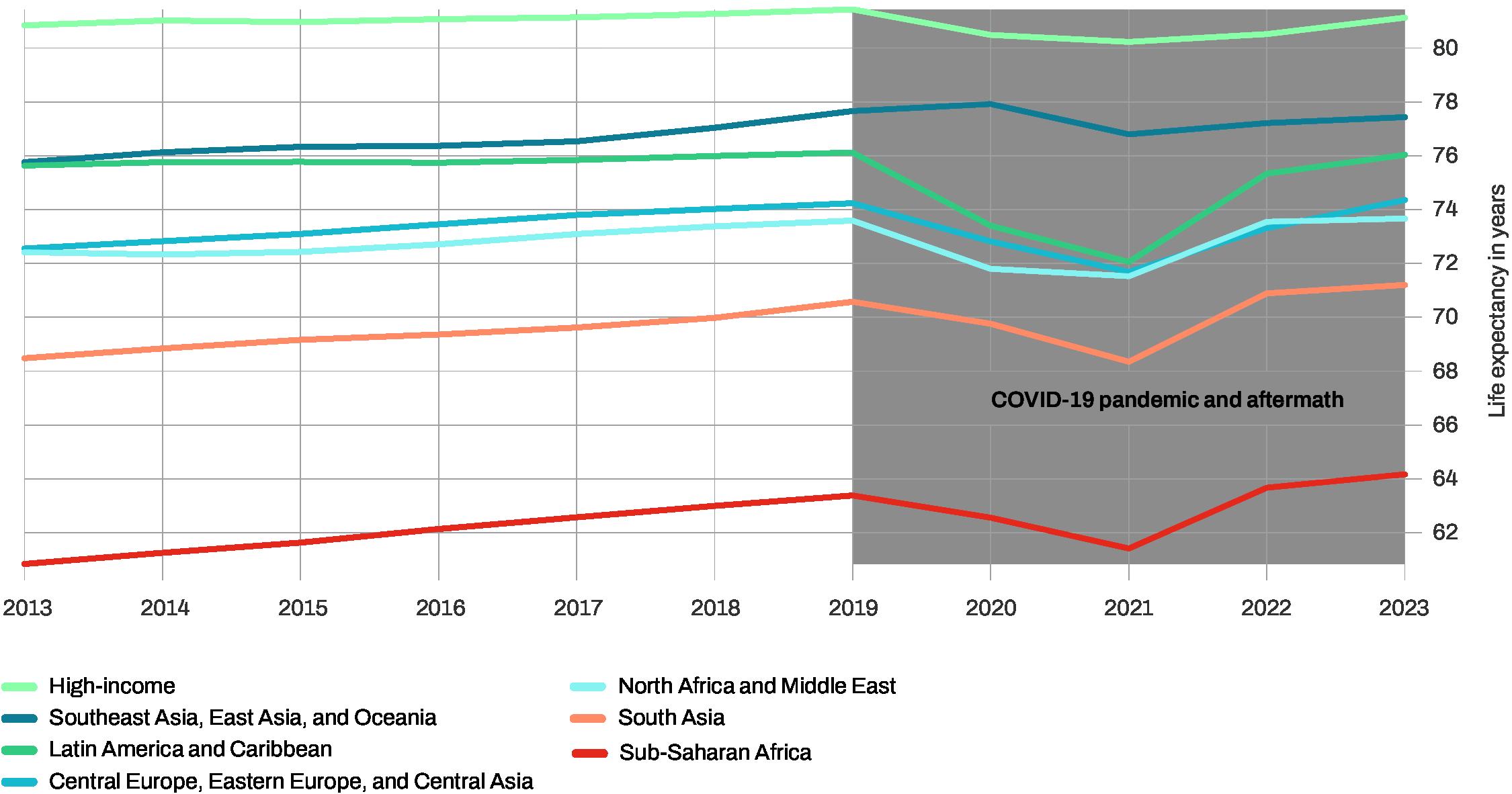
Source: https://www.thelancet.com/journals/lancet/article/PIIS0140-6736(25)01330-3/fulltext,
There are alarming increases in mortality among children and young people in some countries across North America and Eastern Europe.
Mortality among children ages 5–14 (deaths per 100,000 people) in the US and Canada, 1990–2023
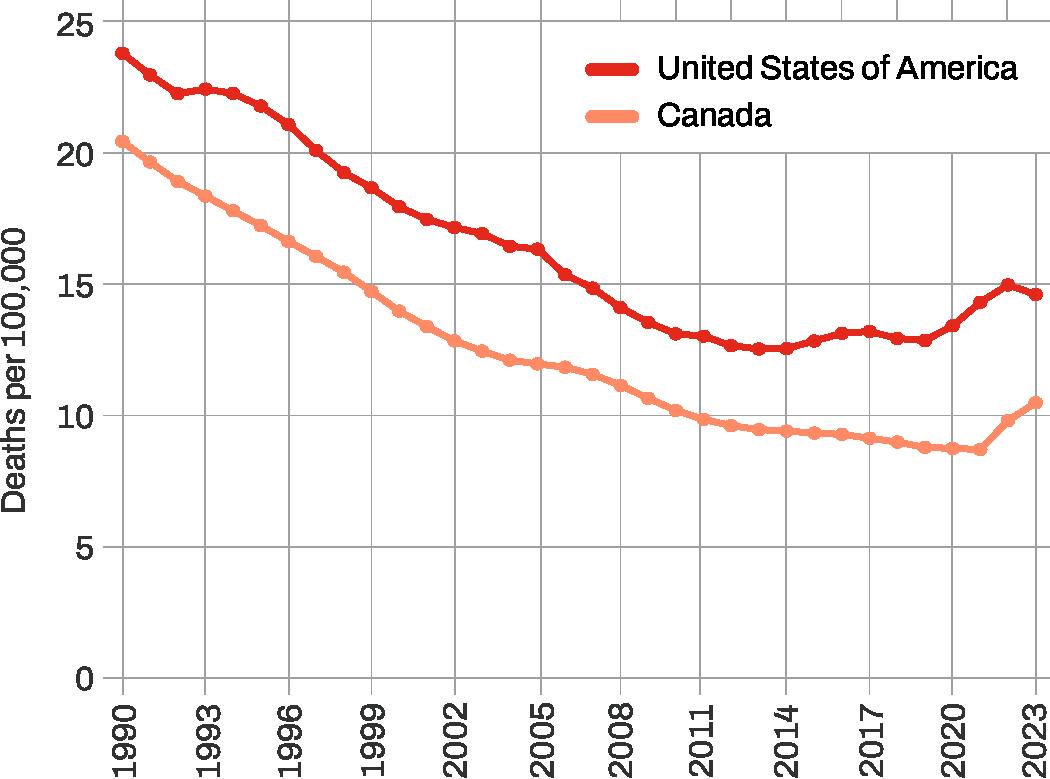
Note: Greenland, which is included in the GBD region of high-income North America, is excluded from this chart to improve readability. To see Greenland’s estimates, visit https://vizhub.healthdata.org/gbd-compare.
Mortality among those aged 15–24 years (deaths per 100,000 people) in Eastern European countries, the US, and Canada, 1990–2023
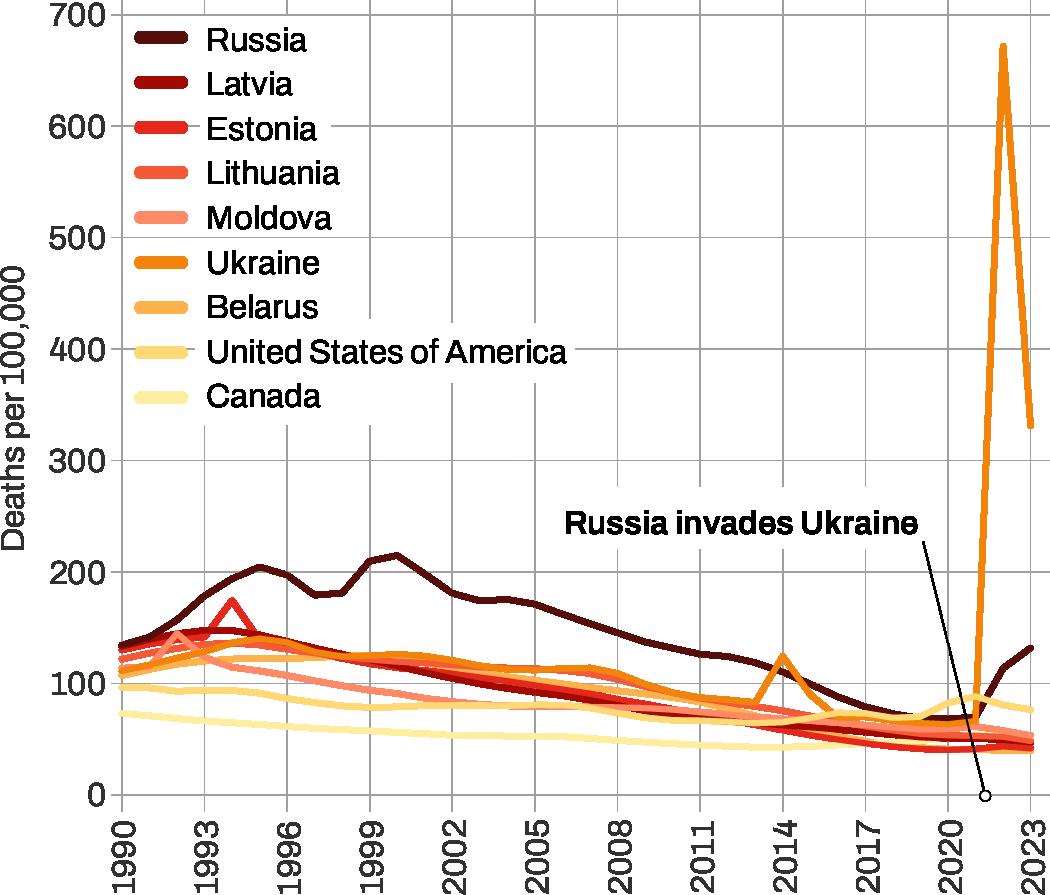
New data and methods indicate that mortality among girls and women (ages 15–29 years) in sub-Saharan Africa is 61% greater than previously reported.
Mortality among females ages 15–29 years (deaths per 100,000 people) among GBD super-regions
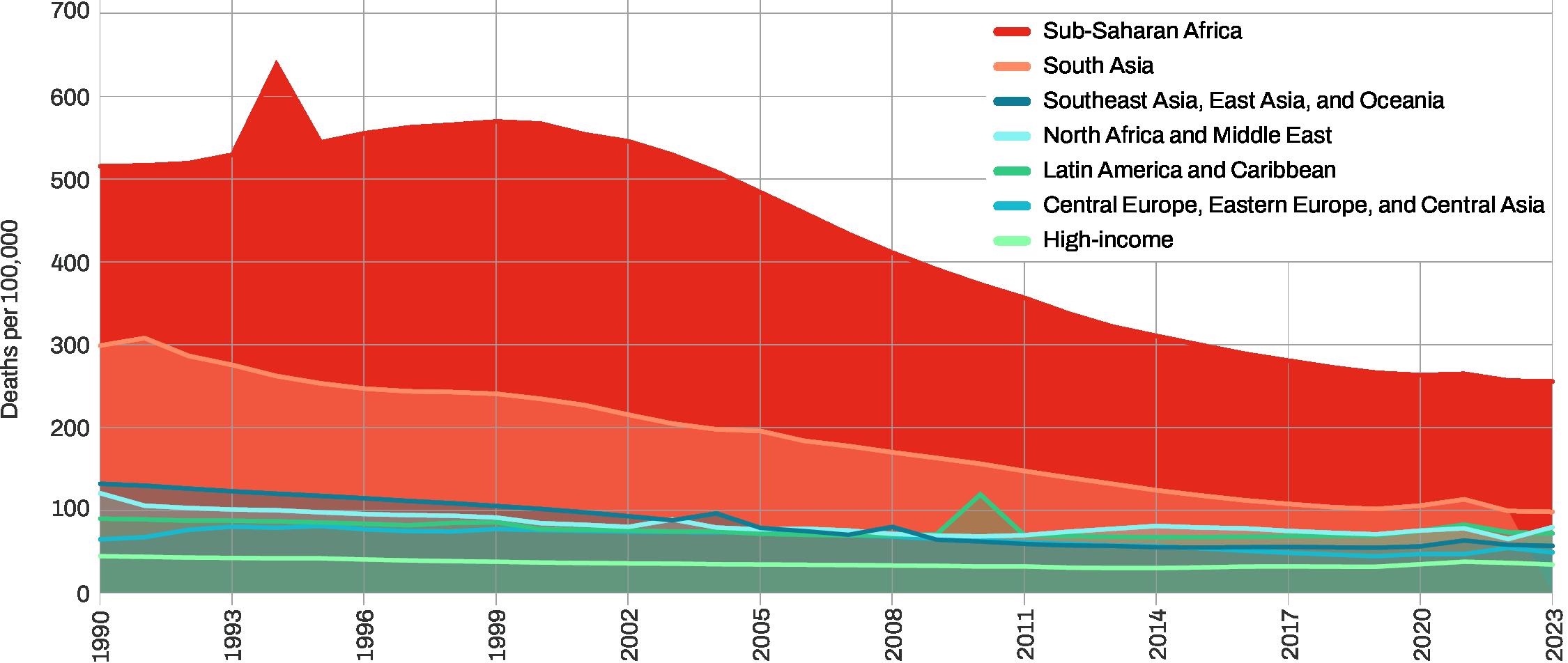
Between 2013 and 2023, there were sharp increases in healthy years lost due to diabetes and anxiety and depressive disorders.
Addressing risk factors, particularly high blood pressure, air pollution (particulate matter), smoking, high blood sugar, and high body mass index (obesity/overweight), could halve the number of healthy years lost each year globally.
Early death and poor health from infectious diseases have declined dramatically, and newborn health has improved, yet disorders of newborns remain the second-leading cause of health loss worldwide.
Half of the top 10 leading causes of early death and disability worldwide are non-communicable diseases.
Leading causes of early death and poor health globally, 20231

1Leading causes of disability-adjusted life years in 2023 for all sexes, all ages, Level 3 of the GBD hierarchy.
Analyzed over 120,000 data sources for disease and injury burden and 59,000 data sources for risk factors.
Added five new causes: ulcerative colitis; Crohn’s disease; thyroid diseases; other endocrine, metabolic, blood, and immune disorders; and electrocution.
Improved methods, especially related to childhood sexual abuse, intimate partner violence, and lead exposure.
Among non-communicable diseases, some of the fastest growing have been diabetes and depressive and anxiety disorders.2
Healthy years lost due to diabetes, anxiety disorders, and depressive disorders (age-adjusted), 2013–2023
Age-standardized disability-adjusted life years per 100,000, all sexes
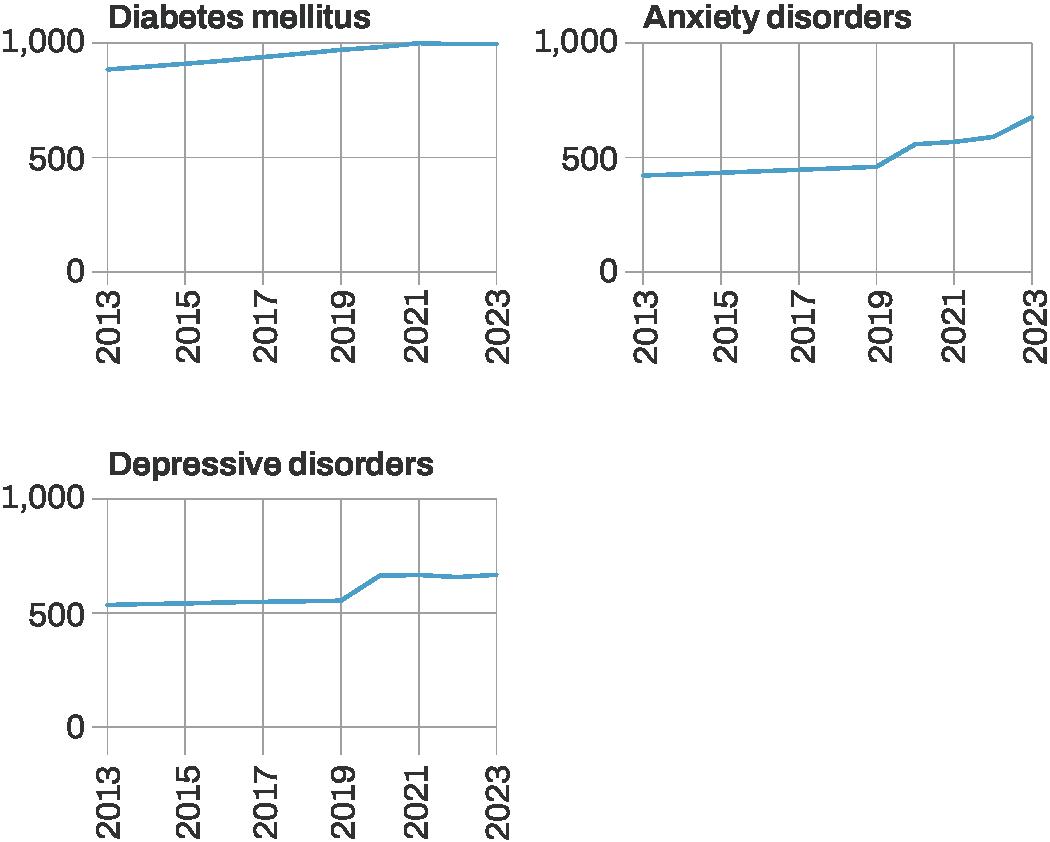
2Measured by increase in age-standardized disability-adjusted life years, all sexes, 2013–2023.
Tremendous progress has been made in slashing many infectious diseases and injuries and in improving the health of newborns, but cuts to development assistance for health threaten this success.3,4
Healthy years lost due to injuries, tuberculosis, malaria, HIV/AIDS, and newborn disorders (age-adjusted), 1990–2023
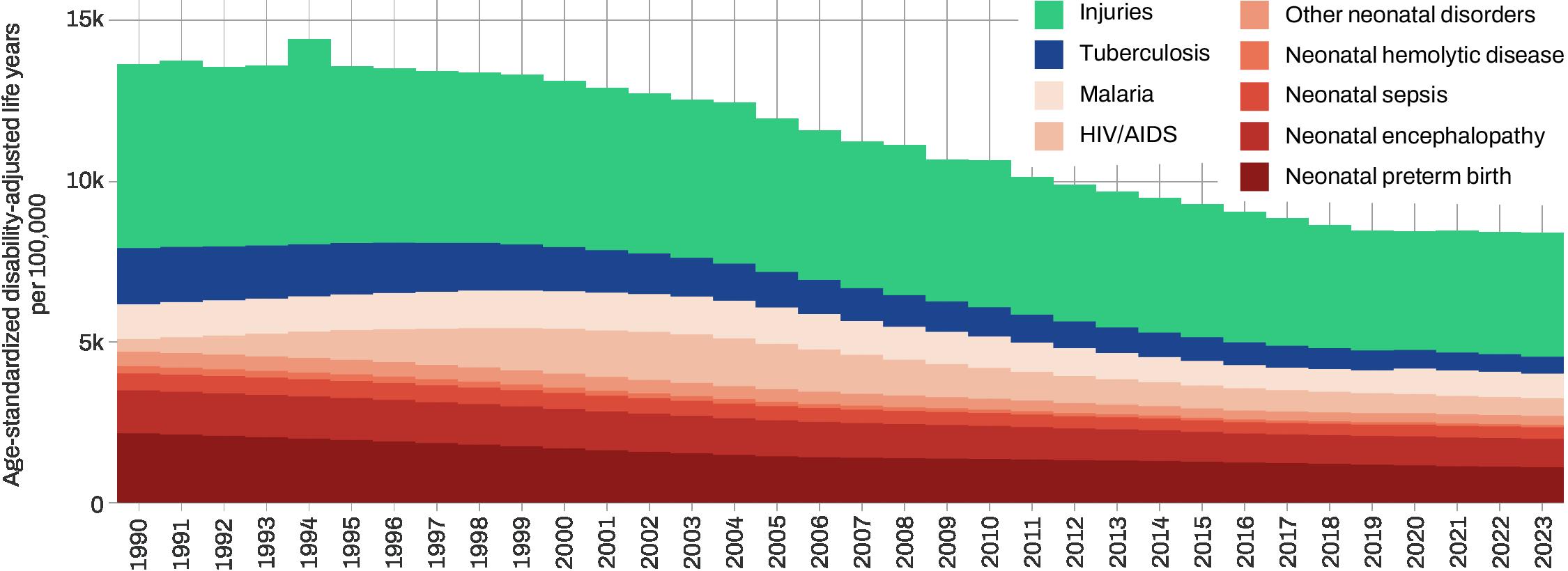
3Measured by reduction in age-standardized disability-adjusted life years, all sexes
4For more information, see Financing Global Health 2025: https://www.healthdata.org/research-analysis/library/financing-global-health-2025-cuts-aid-and-future-outlook
High blood pressure, air pollution (particulate matter), and smoking are the three leading risk factors for early death and disability worldwide.
Leading risk factors for early death and poor health globally, 20235
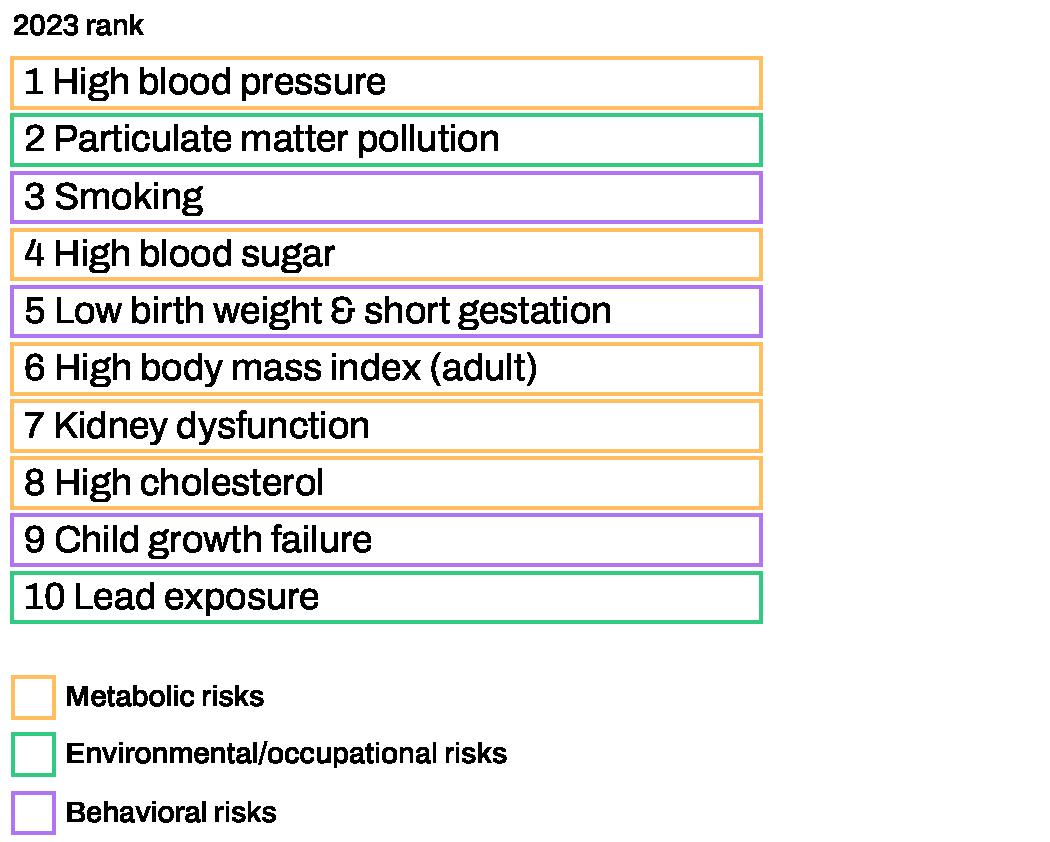
5Ranking reflects percentage of total disability-adjusted life years attributable to leading risk factors for all ages and all sexes, Level 3 of the GBD hierarchy.
Health loss from high blood sugar and high body mass index is rising, but for many other risk factors it is dropping.
Change in early death and disability attributable to the 10 leading risk factors globally, 2010–20236
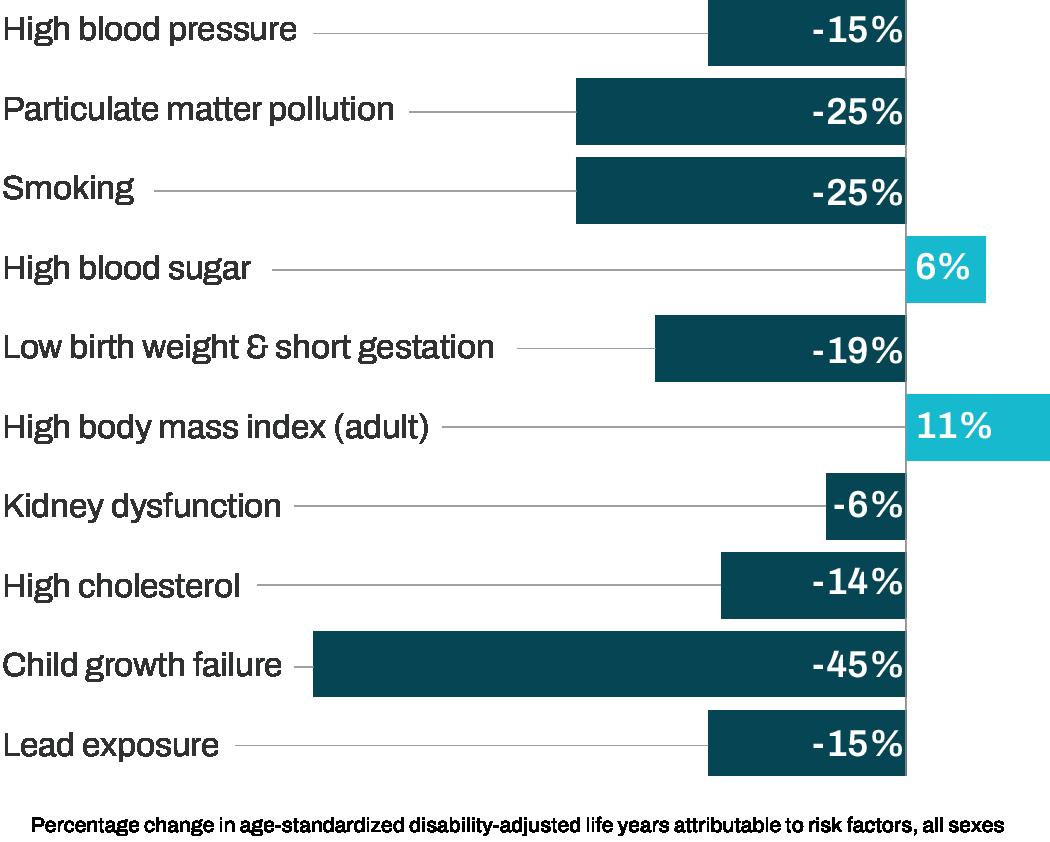
6Ranking reflects percentage of total disability-adjusted life years attributable to leading risk factors for all ages and all sexes, Level 3 of the GBD hierarchy.
Information about the study
https://www.healthdata.org/research-analysis/gbd
Global Health Data Exchange (GHDx)
https://ghdx.healthdata.org/gbd-2023
Interactive data visualizations
GBD Compare http://vizhub.healthdata.org/gbd-compare
GBD Cancer Compare http://vizhub.healthdata.org/gbd-compare/cancer
GBD Results tool https://vizhub.healthdata.org/gbd-results (NEW!) GBD Sex Differences http://vizhub.healthdata.org/gbd-compare/sex-differences
Burden of Proof https://vizhub.healthdata.org/burden-of-proof Country- and subnational-level profiles https://www.healthdata.org/research-analysis/health-by-location/profiles
Sources https://ghdx.healthdata.org/gbd-2023/sources
Training and workshops https://www.healthdata.org/research-analysis/training
Collaborator Network https://www.healthdata.org/research-analysis/gbd/collaborator-network Podcasts https://www.healthdata.org/news-events/podcasts Videos https://www.healthdata.org/news-events/videos
Social media and email




ihme@healthdata.org
Download results and other GBD data: http://ghdx.healthdata.org/gbd-2023